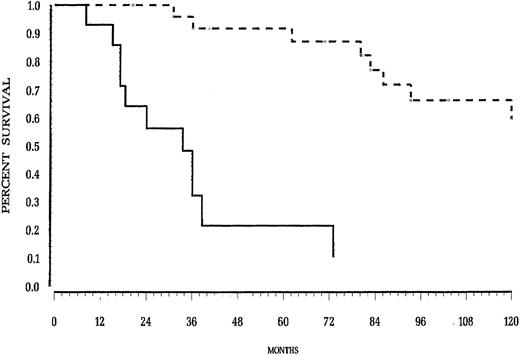To the Editor:
In the interesting report by Dupriez et al,1 the investigators conclude that their staging system could be used to identify patients who might receive newer therapies, such as bone marrow transplantation. Before putting their data to that use, it would be important to know how their prognostic features predicted survival for the patients less than 55 years of age (who might be considered for bone marrow transplantation). Although there is no reason to believe that the factors they identified would not be valuable in the younger patients, the data in this subset of patients would be greatly appreciated.
Response
Thirty-nine of the 195 patients with agnogenic myeloid metaplasia (AMM) recently reported1-1 were ≤55 years old. The prognostic features for survival in this subgroup of patients were evaluated by the log-rank test. The parameters significant at the .05 level were introduced in a proportional hazards model regression analysis with the stepwise selection. There were 22 women and 17 men. The median age was 51 years. Eleven patients were ≤45 years old. Fifteen patients presented with prominent splenomegaly (≥10 cm below costal margin). Anemia (hemoglobin <10 g/dL), leukopenia (<4 × 109/L), white blood cell count (WBC) greater than 30 × 109/L, thrombocytopenia (<150 × 109/L), and thrombocytosis (>500 × 109/L) were found in 10, 2, 4, 7, and 9 patients, respectively. Peripheral immature granulocytes greater than 5% were present in 23 patients. Myelofibrosis was graded I in 11 patients, II in 22, and III in 6 patients. The karyotype was normal in 15 patients and abnormal in 5 patients: del(13q), trisomy 21, add(21)(p11), del(12)(q22), and t(9; 21)(p23; q11). Based on the LILLE score, 25 patients were at low risk, 12 at intermediate risk, and 2 at high risk. Anemia ( P = .008) and intermediate- or high-risk score ( P = .005) were less frequent in patients ≤55 years of age than in older patients. Twenty-three patients received single-agent oral chemotherapy, 5 patients received androgen, and 9 patients underwent splenectomy. At the closing date, 24 patients died (5 from bone marrow failure, 4 from transformation into acute nonlymphoblastic leukemia, 3 from portal hypertension, 3 from cardiovascular complication, 3 from unrelated cause, 2 from cachexia, and 4 from unknown causes). The median survival was 93 months (95 confidence interval [CI], 62 to 204 months), with a median follow-up of 73 months. Adverse prognostic factors for survival were only anemia ( P = .0001) and prominent splenomegaly ( P = .002). The Cox model identified only one independent covariate, namely, anemia. Low-risk patients and intermediate- or high-risk patients had a median survival of 156 (95CI, 93 to 216) and 33 (95CI, 17 to 38) months, respectively ( P = .0001; Fig 1-1). The survival of low-risk patients ≤55 years of age was longer than for older patients ( P = .0008), whereas the survival of intermediate- or high-risk AMM patients was not influenced by age.
Overall survival of the 39 patients according to LILLE score. (solid line) Intermediate or high; (broken line) low.
Overall survival of the 39 patients according to LILLE score. (solid line) Intermediate or high; (broken line) low.
The present analysis showed the adverse prognostic value of anemia, prominent splenomegaly, and unfavorable LILLE score in patients ≤55 years of age. The percentage of patients ≤55 years of age agrees with previous studies.1-2,1-3 The small number of young patients with unfavorable WBC might explain the lack of statistical significance of this parameter. Previous series have pointed out the long survival of AMM patients ≤602 or ≤45 years of age.1-3 These findings may reflect, at least in part, a characteristic of the general population. However, we found that anemia was less frequent and the disease was less frequently aggressive, based on the LILLE score, in patients ≤55 years of age. The median survival of low-risk patients ≤55 years of age (156 months) appeared better than the median survival previously reported1-1 for all low-risk patients (93 months). Moreover, low-risk patients ≤55 years of age had a longer survival time than older patients. Therefore, the confirmation of the prognostic value of splenomegaly, the increased risk of acute conversion associated with an abnormal karyotype, and the adverse prognostic value of abnormal karyotype among low-risk patients1-1 might be useful for the identification of additional patients ≤55 years of age with poor prognosis.
In conclusion, the present data confirmed that the LILLE score could be used to select young AMM patients who might receive newer therapies, such as bone marrow transplantation.



